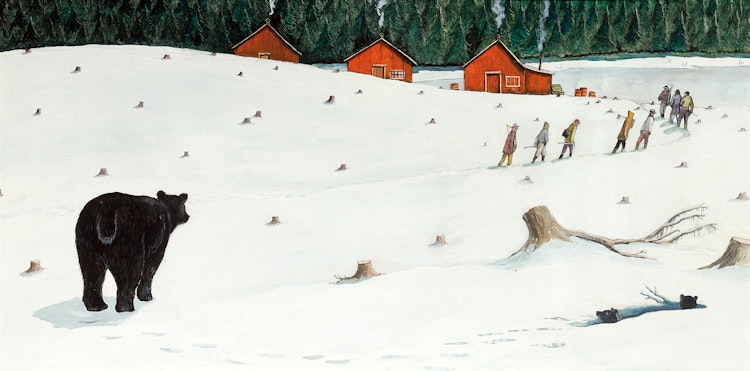Lumberjacks Returning to Camp by William Kurelek

William Kurelek
Lumberjacks Returning to Camp
mixed media on board
signed lower right
17 x 34 in ( 43.2 x 86.4 cm )
Auction Estimate: $70,000.00 - $90,000.00
Price Realized $102,000.00
Sale date: November 27th 2024
Acquired directly from the Artist
Private Collection
By descent to a Private Collection
Joyner Waddington's, auction, Toronto, 25-26 November 2008, lot 68
Private Collection, Toronto
William Kurelek, "Lumberjack", Montreal, 1974, unpaginated
William Kurelek and Joan Murray, "Kurelek’s Vision of Canada", Edmonton, 1983, page 78
Patricia Morley, "Kurelek: A Biography", Toronto, 1986, pages 52-54
Andrew Kear, "William Kurelek: Life & Work" [online publication], Art Canada Institute, Toronto, 2017, page 4
"Lumberjacks Returning to Camp" is no different. A line of lumberjacks trail away from their job site with axes and swede saws in hand, leaving behind remnant stumps as they gladly welcome the comfort of their smoke billowing bunkhouses. Kurelek’s decision to work as a lumberjack occurred at a pivotal moment in his life. It was the first time he gained independence and freedom from his arduous home life and the job would also later fund his art studies in Europe.
The lifestyle of lumberjacks was attractive to Kurelek for what it represented to him as a gateway to independence, and specifically how it connected people from various nationalities and backgrounds. There was also structure and community. As Kurelek describes, “at all the camps there was the same yarn-telling, backslapping, humor and feast-sized meals, the same admiration for physical prowess, skill and productivity.” Kurelek was struck by how rapidly the practice of lumberjacking had changed over time, both in living conditions and technologies, remarking, “as a few students arrived armed with new gadgets called ‘power chainsaws.’” As this was something not often written about or captured visually, Kurelek felt a responsibility to do so.
Lumberjacking was a decision largely unsupported by his father, whose anger Kurelek wrote, “lasted until the very morning I was to leave.” Andrew Kear explains in "William Kurelek: Life & Work" that his “mental anguish and a fraught relationship with his parents, especially his father, defined Kurelek’s journey into adulthood.” Perhaps Kurelek, whose artwork was often representational and full of meanings, depicted a bear with its cubs looking towards the fleeting lumberjacks as a symbol of his own family watching his departure. The barrenness and solemness of the landscape, stripped of its trees, is being left behind for greener and more lush forests ahead.
Regardless of the meaning, William Kurelek felt “very lucky to have [had] experienced traditional lumbercamp living before it disappeared forever.” Kurelek kept this lifestyle alive through his images and through the legacy of his artistic career.
Share this item with your friends
William Kurelek
(1927 - 1977) RCA
Born on a farm near Willingdon, Alberta in 1927, William Kurelek created paintings that explored the reality of farm life during the Depression, with a focus on Ukrainian experiences in Canada. Kurelek’s mother’s family settled in Canada during one of the first waves of Ukrainian immigration in 1899 before the painter’s father arrived in Alberta from Western Ukraine during the second major wave to the province in 1923. In 1934, Kurelek’s family moved to Manitoba, near Winnipeg, due to falling grain prices and a fire that destroyed their home. Upon moving to Manitoba, Kurelek began attending school at the Victoria Public School.
Influenced by the apprehension surrounding the Depression, World War I, and the instability of farming, Kurelek focused on his studies. However, his father did not approve. While Kurelek’s father valued physical labor on the farm, Kurelek concentrated on school and drawing, which caused tension in his household. As a child, Kurelek covered his room in drawings from literature, dreams, and hallucinations. At school, Kurelek’s classmates were enthralled by his stories and drawings.
In 1943, Kurelek and his brother attended Isaac Newton High School in Winnipeg. While in Winnipeg, he frequented Ukrainian cultural classes offered by St. Mary the Protectress. In 1946, Kurelek enrolled in the University of Manitoba studying Latin, English, and history. While in university, Kurelek’s mental health spiraled, which he later self-identified as depersonalization.
After university, in 1948, Kurelek’s family relocated to a farm near Hamilton, Ontario. The next fall, in 1949, Kurelek began studying at the Ontario College of Art working towards a career in commercial advertising. While in school he was uninterested in the competitiveness and emphasis on earning high grades. So, he decided to study with David Alfaro Siqueiros in San Miguel de Allende, Mexico. During his hitchhike to Mexico, Kurelek experienced his first mystical experience while sleeping in the Arizona desert. In this vision, a robed figure asked him to look after his sheep. Upon his arrival to Mexico, Kurelek learned that Siqueiros had departed, and the program was under new direction by Sterling Dickinson. Dickinson’s program was more informal and allowed Kurelek to become aware of social issues and develop his belief system.
Kurelek returned to Canada in 1951 and traveled to England in 1952 where he was admitted into a psychiatric treatment center at London’s Maudsley Hospital. The doctors noted the severity of his illness as well as his artistic talent. After his discharge, Kurelek traveled throughout Europe to view works by Northern Renaissance painters, such as Jan van Eyck and Hieronymus Bosh. In 1953, Kurelek was readmitted into Maudsley, then transferred to Netherne Hospital in Surrey, which had a cutting-edge therapy program. He continued to paint during this time. In early 1955, Kurelek was discharged and returned to London where he worked at an art framing studio, apprenticing with Frederick Pollock.
“Stephen Franklin in ’Weekend Magazine’ described his years in England as follows, ‘In seven years Kurelek found both happiness and sadness in London. His painstaking fool-the-eye paintings of pound notes and other objects found their way into three Royal Academy summer shows, but he was increasingly bothered by eye trouble for which there was no physical cause. He plumbed the depth of emotional despair, contemplated suicide, and wound up in hospital for more than a year. It was here that he began his conversion – from boyhood membership in the Orthodox Church and subsequent atheism – to Catholicism which has deeply affected his life since.’
It was there that he drew many self-portraits and scenes of farm life from his youth. He also developed his unique style of outlining the drawing with a ballpoint pen, using coloured pencils for texture and adding details in pen. Careful examination of his drawings reveals images full of realism with minute details of things like cots, clothes and even insects. Under the pen of William Kurelek, prairie farm scenes and landscapes came to life.”
Kurelek permanently returned to Canada in 1959. Later that year he met Avrom Isaacs, of Isaacs Gallery, who invited him to work in his gallery’s frame shop and hosted his first solo exhibition in 1960. In 1962, Kurelek married Jean Andrews and they relocated to the Beaches area in Toronto. Following the Cuban Missile Crisis, he began painting in a “fire and brimstone” style and constructed a fallout shelter in his basement, which eventually became his studio. He visited Ukraine in 1970 and 1977 and during this period he took a multicultural approach to his art. After his second trip to Ukraine he was admitted to St. Michael’s Hospital in Toronto and soon passed away from cancer.
Literature Sources:
Andrew Kear, “William Kurelek: Life and Work”, Art Canada Institute, Toronto, 2017 (https://aci-iac.ca/art-books/william-kurelek)

